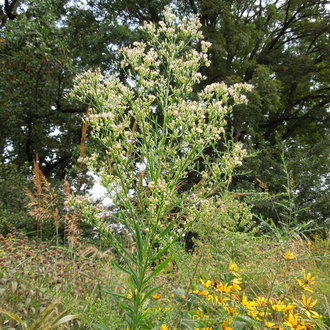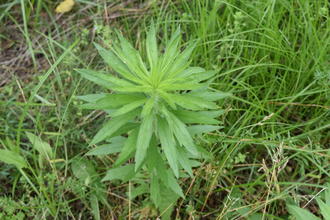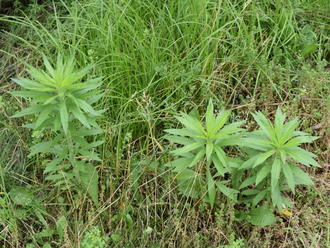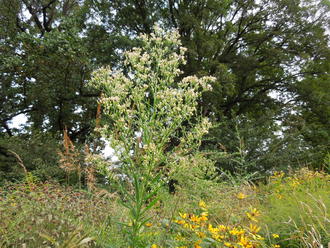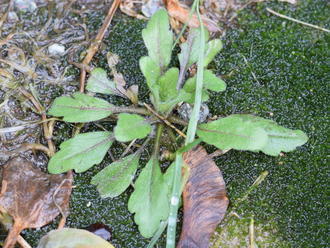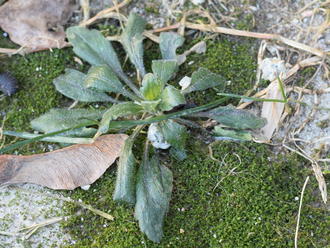Horseweed (Erigeron canadensis L.)
Also classified as Conyza canadensis (L.) Cronquist.
↑Summary
Horseweed is an annual plant, native to North America and widely distributed across the continent. It has been introduced to temperate zones in Asia, Europe, and Australia. It is a frequent weed in agricultural lands, especially in no-till agriculture.
↑Range - Expand
| Legend | Color |
| Native | |
| Native or Not Present |
This tentative map is based on our own research. It may have limited data on Canada and/or Mexico, and there is some subjectivity in our assignment of plants as introduced vs. expanded. Read more in this blog post.
Although this plant occurs somewhere in each of these regions, it may only occur in a small part of some or all of them.
↑Description & Identification
Usually unbranched except at the very top of the plant when it blooms. The plant will sometimes branch at the base in response to being cut. Grows upright and straight, and usually maintains this habit even without support of other vegetation.
Height is highly variable, from 1/2 foot(1.4dm) to 7ft(2m) tall, governed by nutrient content and water supply. In early spring plants are usually only a few inches tall; plants grow steadily through the growing season until they reach full height before blooming.
Stem is usually hairy, but some (uncommon) varieties exist with hairless stems.
Sometimes confused with goldenrod (Solidago sp.) due to similar growth habit and habitat, and slightly similar leaves, but easily distinguished at maturity by its flowers.
↑Habitat
Prefers full sun and exposed conditions, dry to average moisture conditions. Tolerates a wide range of soils, including rocky, clay, and eroded soils and can grow in small cracks in pavement and concrete. Grows larger and more vigorously in rich soils.
Mostly found in disturbed areas where the soil has been exposed, including cropland, roadsides, railroads, vacant lots, industrial areas, and unmaintained areas in cities. Especially common in no-till agriculture. Humans have hugely increased the habitat for this species.
In nature, found mainly in disturbed areas of grasslands.
↑Life Cycle
Many sources describe horseweed as a summer annual, but according to a University of Illinois Extension bulletin, horseweed usually emerges in the fall, and only sometimes in spring or later. Unlike most winter annuals, horseweed completes most of its lifecycle during the spring and summer, and does not set seed until late summer.
When it sprouts early, the plant persists through winter and early spring as a basal rosette, growing low to the ground, and begins to grow upright as the temperatures warm.
The plant is drought-resistant, but will lose its lower leaves in drought. It can survive being cut to the ground if it happens early enough in the season, but cannot survive mowing or repeated cutting.
The flowers are insect-pollinated, but also self-fertile.
Seeds are wind-dispersed.
↑Uses
According to Eat The Weeds, this plant has been historically used by native Americans both as a food source and for medicinal purposes, and it also, when dried, is one of the best choices to use for the "hand drill" method of starting a fire using friction. It is usually too fragile to be used with a bow.
↑Related Plants
In the scheme we use, Erigeron canadensis is classified in the Caenotus Section of the Erigeron genus, along with the other species formerly classified as Conyza, many of which are also called "horseweeds".
There are numerous species in this section globally. Of them, E. canadensis is the only one species in much of its native range, but the very different looking dwarf horseweed (Erigeron divaricatus) occurs in the center of the continent, mostly concentrated in Missouri and Kansas. It is much less common in most of its range. asthmaweed (Erigeron bonariensis) and manzanilla horseweed (Erigeron laevigatus) have also been introduced to North America, and some sources also report asthmaweed (Erigeron floribundus).
Numerous other Erigeron species overlap with this species native range.
↑Notes
This species is known to have evolved resistance to the herbicide glyphosate(source), and also has shown some resistance (source) to other herbicides.
↑Links & External Resources
• Conyza canadensis (Horseweed) | Illinois Wildflowers (About This Site)
• Conyza canadensis (Horseweed) | USDA PLANTS Database (About This Site)
• Horseweed | iNaturalist (About This Site)
• Erigeron canadensis | Biota of North America Project (BONAP) (About This Site)
• Conyza canadensis | NatureServe Explorer (About This Site)
• Conyza canadensis | Flora of North America (About This Site)
• Conyza canadensis | Missouri Plants (About This Site)
• Canadian Horseweed | Maryland Biodiversity Project (About This Site)
• Canadian Horseweed | Maryland Biodiversity Project (About This Site)
• Southern Horseweed | Maryland Biodiversity Project (About This Site)
• Conyza canadensis (Canadian Horseweed) | Minnesota Wildflowers (About This Site)
• Erigeron canadensis L. | Plants of the World Online (POWO) (About This Site)



